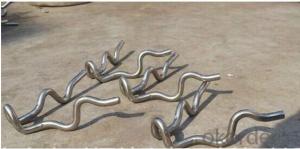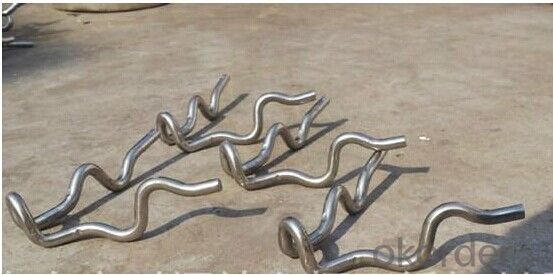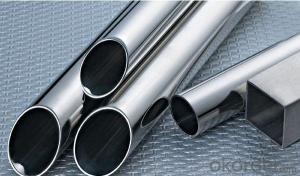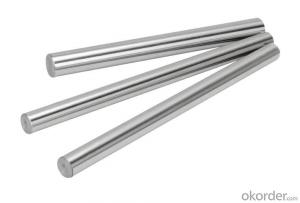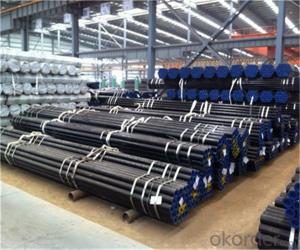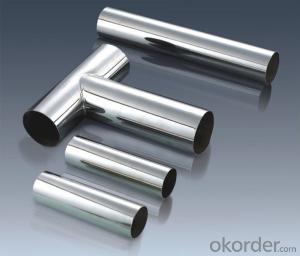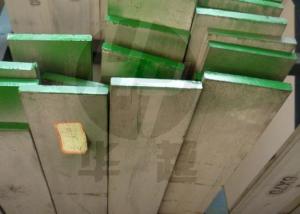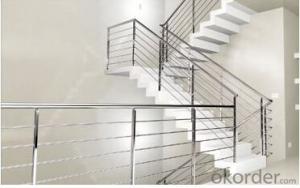Stainless Steel 304 Claw Used in the steel
- Loading Port:
- Qingdao
- Payment Terms:
- TT OR LC
- Min Order Qty:
- 500 set
- Supply Capability:
- 2000 set/month
OKorder Service Pledge
OKorder Financial Service
You Might Also Like
Specifications
stainless steel ss304 pipe price list
OD:6mm-630mm
T:0.3-60mm
Finish: POLISH,ACID,HL,200# polishing, 400 # polished
stainless steel ss304 claw
Stainless steel is a production which not easy rust,acid resistance and corrosion resistance, so it is widely used in light industry,heavy industry,daily necessities and the decoration industry. My company long-term supply stainless steel products, including stainless steel seamless pipes,stainless steel bar and stainless steel sheet. The material have 201,202,301, 309 309S 310, 310S,304,304L, 316, 316L,317, 317L,321,409L, 904L, 410, 430,4Cr13.
claw | ||
material | GB | 10#,20#,45#,20G.16Mn,27SiMn,15CrMoG,12Cr1MoU,20CrMo,35CrMo, 42CrMo, 12Cr1MoVG,Cr5Mo,WB36,BCrMo44,34CrMo4,P5,12Cr |
AISI | 1010,1020,1045,Gr·65 ,API X52,API X 42and so one | |
other | DIN,JIS | |
specification | Out diameter | 6mm-750mm |
Wall thickness | 0.3-75mm | |
Production technology | Hot rolled | |
Cold rolled | ||
Surface treatment | Copper coated | |
Galvanized | ||
other | ||
sorting | Structural pipe, fluid pipe, boiler pipe, oil pipe, gas pipe, API pipe, alloy steel pipe, carbon steel pipe and so on. | |
Application:
Construction field ,ships building industry ,petroleum and chemical industries ,war and electricity industries ,food processing and medical industry, boiler heat exchanger ,machinery and hardware fields |
- Q: Are stainless steel pipes suitable for desalination plants?
- Yes, stainless steel pipes are highly suitable for desalination plants. Stainless steel is corrosion-resistant and has excellent durability, making it ideal for withstanding the harsh conditions and corrosive nature of the desalination process. Additionally, stainless steel pipes offer good heat transfer properties and maintain the quality of water, ensuring a reliable and efficient desalination process.
- Q: What is the significance of the schedule in stainless steel pipes?
- The schedule in stainless steel pipes refers to the thickness of the pipe walls. It plays a significant role in determining the strength, durability, and pressure handling capabilities of the pipe. The schedule is denoted by a numerical value, such as Schedule 10, Schedule 40, or Schedule 80, which represents the thickness of the pipe. The significance of the schedule lies in its impact on the pipe's ability to withstand various applications and conditions. A higher schedule number indicates a thicker wall, which translates to increased strength and resistance to internal and external pressures. This makes stainless steel pipes with a higher schedule suitable for high-pressure and high-temperature applications, such as industrial processes, oil and gas pipelines, and chemical processing plants. Moreover, the schedule also affects the flow capacity of the pipe. Thicker-walled pipes have a smaller internal diameter, reducing the flow rate compared to pipes with thinner walls. This factor is crucial when considering the fluid flow requirements in plumbing systems, HVAC installations, and other applications. The choice of the appropriate schedule for stainless steel pipes depends on the specific requirements of the project, including the pressure, temperature, and flow conditions. It is essential to select the correct schedule to ensure the pipe can handle the intended application safely and efficiently. In summary, the significance of the schedule in stainless steel pipes lies in its influence on the strength, pressure handling capabilities, and flow capacity. By understanding the schedule, engineers and professionals can make informed decisions when selecting and installing stainless steel pipes for various industrial, commercial, and residential applications.
- Q: What are the common shapes of stainless steel pipes?
- Stainless steel pipes come in various shapes that are widely utilized across different industries. These shapes comprise of round pipes, square pipes, rectangular pipes, and oval pipes. Round pipes rank among the most prevalent shapes and find extensive use in diverse applications. They are primarily employed for fluid and gas transportation, as well as the conveyance of other materials. Furthermore, round pipes are well-suited for structural purposes like handrails, scaffolding, and support beams. Square pipes possess a square cross-section and are commonly employed in construction projects, architectural designs, and furniture manufacturing. They offer a sleek and contemporary appearance, often utilized for framing structures, manufacturing shelves, and creating decorative elements. Rectangular pipes possess a rectangular cross-section and are frequently utilized in the construction, engineering, and manufacturing industries. They are often employed in building frameworks, manufacturing gates, fences, and various structural components. Oval pipes possess an elliptical or oval shape and are used in applications where aesthetics play a significant role. They are a popular choice in architectural designs, the automotive industry, and decorative applications. In conclusion, the selection of stainless steel pipe shape depends on the specific requirements of the application and desired aesthetics. Each shape offers distinct advantages and is chosen based on factors such as strength, durability, ease of fabrication, and overall design requirements.
- Q: How do stainless steel pipes compare to titanium pipes?
- Stainless steel pipes are generally more cost-effective and readily available compared to titanium pipes. While both materials offer excellent corrosion resistance, titanium pipes have superior strength and durability. However, titanium pipes are significantly more expensive and may require specialized welding techniques. Ultimately, the choice between stainless steel and titanium pipes depends on the specific application and budget constraints.
- Q: What is the welding of stainless steel?
- If batch welding, it is recommended to use laser welding, welding heat affected area is small, weld appearance, speed, more suitable for thin plate,
- Q: How do you prevent condensation in stainless steel pipes?
- To prevent condensation in stainless steel pipes, there are several measures you can take: 1. Insulation: Apply insulation materials, such as foam or fiberglass, around the pipes. This will help maintain the temperature inside the pipe, preventing the outer surface from becoming cold and reducing the likelihood of condensation. 2. Vapor barriers: Install vapor barriers around the pipes to prevent moisture from reaching the pipe surface and causing condensation. These barriers can be made of materials like plastic or aluminum foil and should be properly sealed to ensure their effectiveness. 3. Increase pipe temperature: If possible, increase the temperature of the fluid or gas flowing through the pipes. This can be achieved by adjusting the temperature of the heat source or utilizing heat tracing systems that provide a constant heat supply to the pipe. 4. Proper ventilation: Ensure there is adequate airflow around the pipes, especially in areas where condensation is more likely to occur. This helps to dissipate any moisture that may accumulate and reduce the chances of condensation. 5. Reduce humidity: In areas with high humidity, consider implementing dehumidification methods, such as using dehumidifiers or installing moisture-absorbing materials, to lower the overall moisture content in the air. This can help minimize the potential for condensation. By implementing these preventive measures, you can significantly reduce the risk of condensation in stainless steel pipes, thereby protecting them from potential corrosion and maintaining their overall performance and longevity.
- Q: What is the hardness of stainless steel pipes?
- The hardness of stainless steel pipes can vary depending on the specific grade and treatment of the steel. Stainless steel pipes have a range of hardness levels, usually measured using the Rockwell scale or the Brinell scale. The hardness of stainless steel pipes is typically higher than that of other types of steel due to the alloying elements, such as chromium and nickel, which provide increased resistance to corrosion and wear. Generally, stainless steel pipes have a hardness level that falls within the range of 75 to 180 on the Rockwell scale or 150 to 300 on the Brinell scale. However, it's important to note that the hardness can also be influenced by factors such as heat treatment, welding, and cold working processes.
- Q: Disadvantages of stainless steel tubes
- Stainless steel composite pipe and aluminum plastic composite pipe in the structure of almost, to some extent, the performance is also relatively close. Similarly, due to the strength of the steel, the construction process is still a problem.
- Q: Can stainless steel pipes be insulated with polyimide?
- Yes, stainless steel pipes can be insulated with polyimide. Polyimide is a type of high-performance insulation material that is widely used in various industries for its excellent thermal stability, electrical insulation properties, and resistance to chemicals. It can withstand high temperatures and is known for its low thermal conductivity. This makes it an ideal choice for insulating stainless steel pipes, especially in applications where heat resistance and energy conservation are important. Polyimide insulation can help reduce heat transfer, prevent condensation, and improve the overall efficiency and performance of stainless steel pipes.
- Q: What is the corrosion resistance of stainless steel pipes?
- Stainless steel pipes offer excellent corrosion resistance due to the presence of chromium in their composition. Chromium reacts with oxygen in the atmosphere to form a thin, protective layer of chromium oxide on the surface of the pipe. This oxide layer acts as a barrier, preventing further oxidation and corrosion of the underlying metal. Additionally, stainless steel pipes are often alloyed with other elements such as nickel and molybdenum, which further enhance their corrosion resistance. As a result, stainless steel pipes are highly resistant to rust, pitting, and other forms of corrosion, making them suitable for a wide range of applications in various industries, including plumbing, oil and gas, chemical processing, and marine environments.
Send your message to us
Stainless Steel 304 Claw Used in the steel
- Loading Port:
- Qingdao
- Payment Terms:
- TT OR LC
- Min Order Qty:
- 500 set
- Supply Capability:
- 2000 set/month
OKorder Service Pledge
OKorder Financial Service
Similar products
Hot products
Hot Searches
Related keywords
